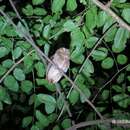Biology
provided by Arkive
A nocturnal bird, the Pemba scops-owl spends its daylight hours roosting amongst the thick foliage of trees, or in dense undergrowth about two metres above the ground (2) (4). As night falls, and with a call of 'hoo hoo hoo'(4), the owls emerge from their hiding and commence their search for food. The Pemba scops-owl feeds primarily on insects, which are swooped down on from a perch, snatched from the air in flight, or plucked off foliage (2) (5).
Almost nothing has been recorded about the breeding biology of the Pemba scops-owl (2), but it is thought to breed between August and October (4), and probably nests in natural holes in trees (2) (5).
Conservation
provided by Arkive
The two forest patches which hold the majority of the Pemba scops-owl population, Ngezi and Msitu Mkuu (3), are both forest reserves, which may offer some degree of protection, but are unfortunately still subject to illegal exploitation (6). Undertaking in-depth population surveys, researching this species' ecology, and investigating methods of controlling illegal activities within the forest reserves are just some of the actions that have been proposed to ensure the survival of this enigmatic owl (3) (6).
Description
provided by Arkive
Described as a 'creature of the night' (3) (4), the Pemba scops-owl is a mysterious bird, identified with witchcraft by the local inhabitants of its island home (4). Two different forms, or morphs, of the Pemba scops-owl exist: a rufous and a brown morph. Both morphs have small ear tufts, light spots on the shoulders and pale 'eyebrows' that vary in their prominence. Often there are striped markings on the wings and outer tail feathers, and the crown and underparts can be streaked (2) (5). The eyes are yellow and the black-tipped bill varies from dull green to yellow-grey (5). In keeping with its enigmatic reputation, the call of the Pemba scops-owl is a long series of monotonous, haunting notes 'hoo hoo hoo…' (2) (4).
Habitat
provided by Arkive
On the lush and hilly island of Pemba, the scops-owl can be found in wooded areas with dense foliage, and overgrown clove and mango plantations (2) (5).
Range
provided by Arkive
Endemic to Pemba Island, situated 50 kilometres off the coast of northern Tanzania (2) (5).
Status
provided by Arkive
Classified as Vulnerable (VU) on the IUCN Red List 2007 (1).
Threats
provided by Arkive
Although the Pemba scops-owl had been thought of as common and widespread, a survey undertaken in 2004 found this to be incorrect, and discovered that it was only common in native forest, a habitat that makes up less than two percent of the island. The Pemba scops-owl was found to occur mainly in two tiny patches of natural forest, Ngezi Forest and Msitu Mkuu (3), and this restricted distribution makes it vulnerable to the effects of continued forest degradation and clearance for agriculture (2). Native forest is threatened by exploitation for building materials, fuelwood, and in some areas, conversion to rubber plantations and infrastructure development (6).
Clove plantations, where the Pemba scops-owl occurs at lower densities, are also now a threatened habitat. A global collapse in clove prices resulted in many farmers clearing clove plantations in order to plant more lucrative crops such as rice and cassava, creating an open farmland habitat entirely unsuitable for the scops-owl (3) (6). In addition, this species' association with witchcraft makes persecution by humans a distinct possibility (2) (5).

